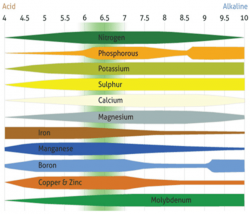PH is a very important parameter when growing crops, as it tells us whether our soil is acidic or alkaline, which, in turn, would determine its chemical, physical and biological properties. The roots absorb minerals from this soil to grow, which is why the pH range is directly related to the nutrition and development of our crops.
The pH measurement scale ranges from 0 (zero) to 14 (fourteen). The most acceptable range being 6.0 to 6.5, although some researchers suggest it may be 5.5 to 7.0.
If we want to have better harvests, it is essential that the pH parameter of our crops’ soil is adequate; that will allow for most of the nutrients to maintain their maximum availability for plants.
When we have a pH below the recommended range, it is very likely that deficiencies of the following macronutrients will occur: Nitrogen, Potassium, Phosphorus, Sulfur, Calcium and Magnesium. However, if we have a pH above the recommended range, the absorption of the following microelements is reduced: Iron, Manganese, Boron, Copper and Zinc.

pH Absorption and Nutrients Ranges
http://www.agropal.com/es/el-ph-del-suelo/
Did you know that the soil’s pH value depends on mainly five factors?
- Alkalinity of irrigation water.
- Organic amendments (composts, fertilizers, etc.) or minerals such as rocks.
- Root acidification.
- Use of acid or alkaline reaction fertilizers.
- Precipitation.
We share the pH levels and their effect on the soil with you below. Based on this, it is very important to identify whether our soil is acidic or alkaline and follow the recommendations:
- A pH level lower than 4.0 indicates the presence of free acids as a by-product of sulfide oxidation.
- A pH range of 1 to 5.5, indicates acidic soil with the presence of interchangeable aluminum and/or an excess of Manganese.
- A pH range of 7.3 and 8.4, indicates the presence of Calcium Carbonates (CaCO3).
- A pH level higher than 8.4 indicates high concentration of sodium(Na).
- Soils with values of 5.5 to 6, and not any lower than this, are considered slightly acidic, for which whitewashing is recommended.
- Soils ranging from 6.5 to 7.5 are considered trouble-free soils, as mentioned above, except in those cases where issues with Sodium Bicarbonate are observed, which could affect the availability of some microelements such as Iron, Zinc, Copper and Manganese, which are reduced in their absorption.
- When we have a pH value of less than 5.5, it is considered an acidic soil, where high levels of Aluminum, Iron and Manganese are observed, which in excess are toxic to plants. Another problem is the low availability of ions and phosphate (H2PO4 and HPO4), which is how plants absorb phosphorus, which is, in turn, essential for the general growth and development of roots and the plant; in these cases, the use of whitewashing is highly recommended.
- Soils with a pH range of 7.3 to 8.4, without becoming sodium, are very difficult to modify, since they are not viable for acid administration; the proper thing approach in this case is a comprehensive management of the soil to avoid problems of absorption of micronutrients and sometimes phosphorus.
At MYCSA AG we consider that the greatest nutrient absorption falls in the 6.0 to 7.0 range, achieving enough organic matter and a living soil, full of microorganisms. We also recommend the use of Humic Acids to improve the structure of tired and worn-out soils, as they facilitate microbial life and enhance root development, permeability and soil aeration.
Would you like to have the perfect pH level in your crops’ soil to get better crops? At Ferti-Organic we offer organic products with the highest quality standards. Come and familiarize yourself with them!
- Bibliography
- Plant Physiology, Ricardo Hugo Lira Saldivar, Ed TRILLAS 2007
- Osorio, N. W. 2012. Soil pH and Nutrient Availability. Rev. Integral Soil Management and Plant Nutrition
- http://www.agropal.com/es/el-ph-del-suelo/
- https://www.acidoshumicos.com/los-acidos-humicos-y-acidos-fulvicos

